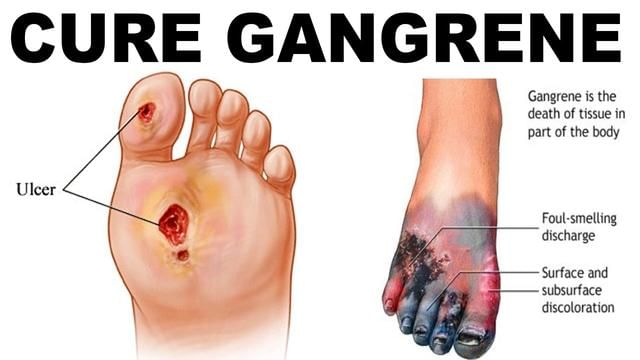Gangrene - In-depth Of It!
Gangrene
In gangrene, body tissue dies due to an inadequate supply of blood. The main cause of gangrene is the loss of blood supply that occurs due to an underlying illness, injury and/or infection. Generally, it affects fingers, toes, and limbs. But it can also occur inside the body which can cause damage to organs and muscles. There are various types of gangrene and all the types need an immediate appointment with the doctor. In certain cases, gangrene can be life-threatening if left untreated. So, it is important that you visit a doctor as soon as you experience or discover the signs or symptoms of gangrene. Check out the various types of gangrene:
- Dry gangrene: All the organs of the body including the liver, heart, and muscles require oxygen in order to function properly and survive. Blood carries the oxygen to all the parts of the body. Dry gangrene is caused when one of the body parts does not get enough oxygen. Because of which the body part starts to deteriorate and die. In dry gangrene, there is no evidence of infection.
- Wet gangrene: When some type of bacteria causes infection in body tissues then it leads to wet gangrene. The tissues grow moist and break down due to the presence of bacteria. This process leads to the death of tissues. In wet gangrene, there are chances of infection reaching to the other parts of the body. Wet gangrene is an emergency condition than the dry gangrene.
- Gas gangrene: Gas gangrene occurs due to a bacteria which is known as Clostridia. This type of bacteria creates an infection due to which gas bubbles and toxins develop inside the affected area. This lead to the death of tissues. Gas gangrene can be fatal.
Symptoms of Gangrene
In dry gangrene, the first symptom that you generally notice is an appearance of a reddish line around the affected area. This reddish line may turn into black colour after some time. You may or may not have the pain in dry gangrene. Check out the various signs or symptoms of gangrene:
- Pain due to an infection
- Red, sore, or swollen wound
- Pus-filled wound
- Bad smell due to a wound
- Feeling cold in an isolated area of your body
- Lacking a sense of touch in an isolated area of your body
- Sores keep coming back in the same place on your body
- Part of your skin may turn into an unusual colour including greenish-black, red, blue, or bronze
- A cracking sound comes when you press the affected area of your body
- Feverish and unwell feeling
Causes of Gangrene
Blood has a very important role to play in your body. It not only sends oxygen and nutrients to the cells of your body but also delivers disease-fighting antibodies that prevent your body from infection. Due to an inadequate supply of blood, cells cannot survive, an infection can grow, tissues can die due to gangrene. There are a lot of conditions that can affect the blood flow in your body and all these conditions increase the risk of gangrene. Check out the various causes of gangrene:
- Diabetes: Due to imbalanced blood sugar levels, blood vessels and nerves can damage. This reduces the oxygen supply to extremities. Dry gangrene can occur due to diabetes.
- Injury: When the wounds sustained in the situations that allow bacterial infection then wet gangrene can occur.
- Immune deficiency: Minor infections escalate more quickly and can become gangrenous due to a weakened immune system which can happen due to HIV, diabetes, long-time alcohol or drug abuse, or recent chemotherapy or radiotherapy.
- Raynaud's disease: In Raynaud's disease, some areas of your body including fingers and toes feel numb and cool in response to certain conditions. Raynaud's disease can lead to dry gangrene.
- Vascular problems: Vascular problems arise generally due to the poor health of arteries and veins in the legs and toes. Diabetes, peripheral arterial disease, and high blood pressure develop vascular problems over time.
- Other causes: Atherosclerosis, obesity, smoking, embolism, trauma, severe burns, scalds, and cold are some of the other causes of gangrene.
How is it diagnosed?
As soon as you experience signs of gangrene, you should reach out to a doctor for a diagnosis. Your doctor will conduct a physical examination and ask you about your medical history. Your doctor will look for the signs of shock or trauma. If your doctor finds out that you are suffering from gangrene then further diagnostic tests will be conducted. These tests are conducted to determine the extent and type of the necrosis. Various tests are conducted for the diagnosis:
- Blood tests: Increase in white blood cells indicate the presence of an infection. Blood tests are also done to check if certain bacteria or other germs present or not.
- Imaging tests: Imaging tests including an x-ray, a computerized tomography (CT) scan or a magnetic resonance imaging (MRI) scan can be done. These tests are done to view the structures of your interior body including internal organs, blood vessels or bones. These tests also help to know the extent of gangrene and see if any gas is present under your skin. An arteriogram is also an imaging test done to produce the images of your arteries. In this test, a dye is injected into the blood circulating through your body and then X-ray images are taken to check the flow of blood through your arteries. This test helps your doctor to know if there is any blockage in your arteries.
- Surgery: Your doctor may conduct a surgery in order to know the extent of gangrene. Surgery is also done to get the samples of tissue. Sometimes, your doctor may remove the dead tissues surgically if required.
- Fluid or tissue culture: A common cause of gangrene is bacterium Clostridium perfringens. A culture of the fluid from a blister on your skin may be examined by your doctor for checking the presence of bacteria. Your doctor may look at a tissue sample under a microscope for signs of cell death.
Prevention of Gangrene
Gangrene can be prevented by preventing the risk factors that can cause gangrene. In order to prevent yourself from gangrene, you should maintain a healthy lifestyle. Check out the various ways that reduce the risk of gangrene:
- You should quit smoking.
- You should not use drugs.
- You should maintain a healthy weight.
- Do physical exercises regularly.
- You should always eat healthy food.
- If you have diabetes problem then follow your doctor's advice in order to keep your blood sugar under control.
- You should avoid or reduce the intake of alcohol.
- Don’t use warfarin and heparin together. Using warfarin and heparin together can increase your risk of gangrene.
Treatment of Gangrene
As soon as you experience the symptoms of gangrene, you should reach out to your doctor. In the early stage, the chances of recovery are more. In gangrene treatment, dead tissues are removed, infection is prevented or treated so that it does not spread, and cause of gangrene is treated. The treatment that will be provided to you by your doctor will depend on:
- Type of gangrene
- Extent of gangrene
- Your medical history
Check out the various treatment options available:
- Surgery: Surgery is also known as debridement. In this treatment option, the dead tissue is removed surgically so that infection does not spread. Sometimes, amputation is required. Amputation is the removal of the affected limb, finger or toe surgically to control pain or a disease.
- Antibiotics: Antibiotics are given in order to treat and prevent infections. These antibiotics are injected into a vein.
- Maggot therapy: It is a non-surgical treatment option used for removing the dead tissues. Maggot therapy is a common medical technique. In this, maggots from fly larva are placed on a wound so that they can consume the infected and dead tissues. They do not harm the healthy tissues. Maggots help to fight the infection and release substances that kill bacteria which helps in speed up healing or recovery.
- Oxygen therapy: In some cases of wet gangrene or ulcers related to diabetes or peripheral artery disease, this treatment option of hyperbaric oxygen therapy may be used. In this, a patient is put into a chamber filled with oxygen. The pressure of oxygen is higher than the oxygen found in the outside air. The high level of oxygen saturates the blood and encourages healing of the dead tissue. This process reduces the growth of a bacteria that cannot grow in an environment that has a high level of oxygen.
It is important to know the cause of gangrene so that you can prevent gangrene from occurring again. Your doctor prescribes the treatment option as per the type and extent of gangrene. Medicines may be used in certain cases to prevent blood clots. It is a serious problem that requires immediate treatment. Dry gangrene can be easily treated with the medicines. Gangrene that involves an infection can be a threat to your life. You should reach out to your doctor as soon as you experience the symptoms of gangrene including persistent and unexplained pain in any area in your body, fever, a wound that is slow to heal, or you notice a change in skin colour. In an early stage, the chances of recovery are higher.
Complications
- Amputation: It is a surgical treatment method in which affected limb, finger or toe is removed to control pain or a disease. This method is used when the amount of tissue death is extensive.
- Infection: In gangrene, a bacterial infection can spread quickly to other parts of the body. It is a serious problem and can be a threat to your life if left untreated or not treated properly on time.
- Life-threatening disease: Gangrene is a fatal problem that can be life-threatening if not treated properly on time or left untreated.
- Large areas of scarring: Gangrene can spread rapidly over a large area of the body and the amount of dead tissue can be quite large. Gangrene can lead to large areas of scarring.
Conclusion
In gangrene, the body tissues die due to lack of blood supply or serious bacterial infection. The various types of gangrene include wet gangrene, dry gangrene, and gas gangrene. Fever, pain due to an infection, feeling cold and lacking a sense of touch in an area of the body, blisters and pus-filled wound are some of the signs of gangrene. As soon as you experience any of the symptoms, you should book an appointment with the best doctor for the diagnosis. In certain cases, it can be a threat to your life if not treated properly or left untreated. Blood tests, imaging tests, surgery, and fluid or tissue culture are various tests conducted to diagnose gangrene. The various treatment options available for treating the problem of gangrene are surgery, antibiotics, maggot therapy and oxygen therapy. You can prevent yourself from gangrene by following a healthy lifestyle which includes maintaining a healthy weight, reducing the intake of alcohol, quitting smoking, eating a healthy diet and more. Amputation is used in the extreme cases in which the affected limb, finger or toe is removed. Your doctor prescribes the treatment method on the basis of the type of gangrene you are suffering from, the extent of your gangrene and your medical history.



+1.svg)
